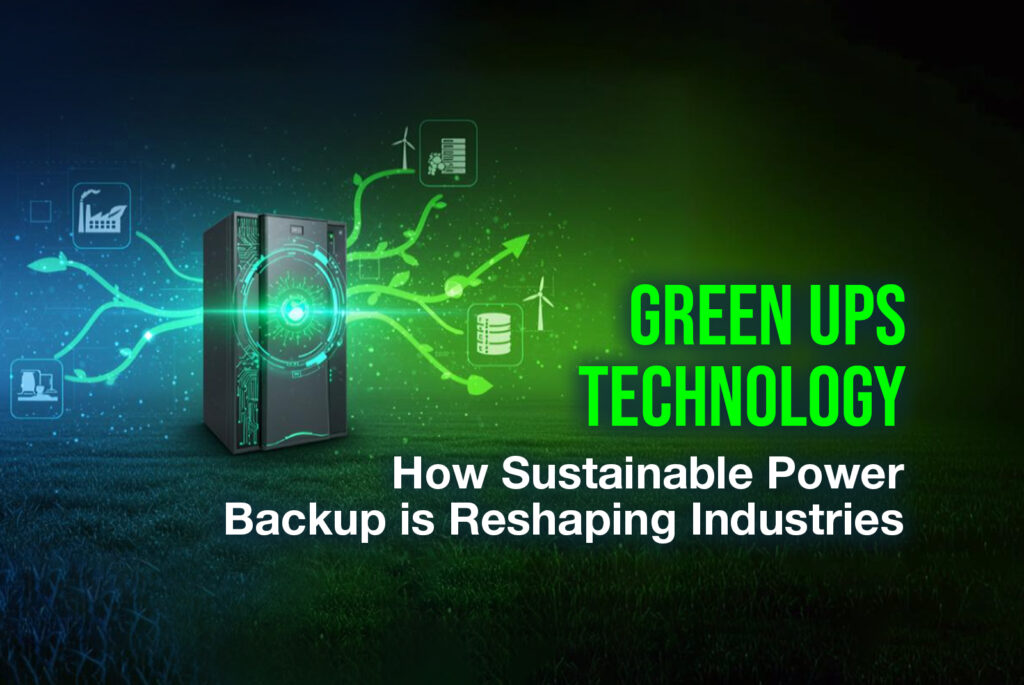Introduction
The growing focus on sustainability, energy efficiency, and carbon neutrality is driving industries to rethink their power backup strategies. Traditional UPS (Uninterruptible Power Supply) systems, while essential for ensuring uninterrupted power, have long been associated with high energy consumption, significant operational costs, and environmental concerns. Many conventional UPS solutions rely on lead-acid batteries, inefficient energy conversion processes, and excessive heat dissipation, all of which contribute to increased power wastage and higher carbon footprints.
With global climate change concerns and stricter carbon reduction targets, businesses across sectors are under pressure to transition toward greener technologies. Green UPS systems have emerged as a game-changing solution that not only guarantees reliable backup power but also reduces energy losses, integrates seamlessly with renewable energy sources, and improves overall efficiency. As industries across data centers, manufacturing, healthcare, IT, and telecom strive to meet their sustainability goals, adopting energy-efficient, AI-powered, and lithium-ion-based UPS systems is becoming imperative.
The Shift Towards Energy-Efficient UPS Systems
For years, businesses have relied on traditional UPS infrastructure to safeguard their operations from unexpected power outages and voltage fluctuations. However, these conventional systems often suffer from low energy efficiency, frequent battery replacements, and high heat generation, leading to increased electricity bills and environmental impact.
In contrast, Green UPS technology is designed with a high-efficiency power conversion architecture, enabling businesses to:
- Reduce energy wastage during power conversion by utilizing advanced rectifier and inverter technologies.
- Optimize battery charging cycles, ensuring lower electricity consumption.
- Enhance cooling efficiency, minimizing the need for energy-intensive air conditioning and thermal management.
By adopting Green UPS solutions, industries can cut down on operational costs, improve power reliability, and align with corporate sustainability initiatives without compromising on performance.
The Role of Lithium-Ion Batteries in Green UPS Solutions
One of the most critical advancements in Green UPS technology is the transition from lead-acid to lithium-ion (Li-ion) batteries. Traditionally, lead-acid batteries have been the backbone of UPS systems, but they come with significant drawbacks, including shorter lifespans, frequent replacements, and hazardous waste disposal issues.
Lithium-ion batteries, on the other hand, offer several advantages:
- Extended Battery Life and Reduced Maintenance Costs
Lithium-ion batteries have a lifespan of 10-15 years, significantly longer than lead-acid alternatives. This reduces the frequency of battery replacements, leading to lower maintenance costs and reduced electronic waste. - Higher Energy Efficiency and Faster Charging Cycles
Green UPS systems with lithium-ion batteries provide higher charge acceptance rates, meaning they recharge faster and hold power longer. This is particularly beneficial for data centers, hospitals, and industrial facilities, where constant power availability is non-negotiable. - Smaller Footprint and Reduced Space Requirements
Lithium-ion batteries are compact and lightweight, requiring less installation space than bulky lead-acid alternatives. This allows businesses with space constraints, such as urban data centers and high-density manufacturing plants, to optimize their floor space efficiently. - Enhanced Environmental Sustainability
Lead-acid batteries contain toxic chemicals, contributing to hazardous waste disposal challenges. In contrast, lithium-ion batteries are more environmentally friendly, with lower emissions and a significantly reduced carbon footprint over their lifecycle.
Renewable Energy Integration: The Future of Green UPS Systems
The transition to Green UPS technology goes beyond battery efficiency—it also involves the integration of renewable energy sources, such as solar and wind power, into industrial power backup systems.
Industries and data centers are increasingly adopting hybrid UPS solutions that combine traditional grid power with solar and battery energy storage systems (BESS). These advanced Green UPS models allow organizations to:
- Utilize solar energy during daylight hours, reducing dependency on fossil fuels.
- Store excess renewable power in batteries, ensuring backup energy availability even during outages.
- Intelligently switch between grid and renewable power sources, optimizing energy consumption and reducing carbon emissions.
For example, solar-powered UPS systems are being widely deployed in remote industrial sites, telecom towers, and commercial buildings, significantly lowering electricity costs while ensuring uninterrupted power supply. By integrating AI-driven energy management systems, businesses can further analyze real-time energy usage patterns, predict peak demand hours, and automate load distribution for maximum efficiency.
AI-Driven Smart Energy Management in Green UPS
Artificial intelligence (AI) and the Internet of Things (IoT) are playing a transformational role in power backup and energy management. Next-generation Green UPS systems are embedded with AI-driven analytics, machine learning algorithms, and real-time monitoring capabilities, enabling organizations to:
- Predict Power Demand and Automate Energy Optimization
Advanced AI-based UPS solutions analyze historical energy consumption data, allowing industries to anticipate power demand fluctuations and optimize battery discharge cycles accordingly. - Reduce Power Losses Through Smart Load Balancing
AI-integrated Green UPS units automatically adjust power distribution, preventing overloading and minimizing power wastage. This ensures better load balancing, especially in power-intensive environments like manufacturing plants and data centers. - Enable Remote Monitoring and Predictive Maintenance
IoT-enabled UPS systems offer real-time status updates on battery health, power usage, and performance anomalies. Predictive maintenance alerts help prevent unexpected failures, ensuring continuous uptime and long-term cost savings.
Industries Adopting Green UPS Technology
1. Data Centers: Minimizing Carbon Footprint and Energy Costs
The global data center industry consumes massive amounts of energy, making sustainability a top priority. Leading cloud service providers and IT giants are shifting toward high-efficiency Green UPS systems with AI-powered energy optimization and lithium-ion battery backup to reduce power losses and achieve carbon neutrality goals.
2. Manufacturing: Supporting Energy-Efficient Production
With industries under pressure to cut emissions and improve operational efficiency, manufacturing plants are deploying solar-integrated UPS solutions to power critical operations while reducing electricity expenses and environmental impact.
3. Healthcare: Ensuring Clean and Reliable Power for Critical Equipment
Hospitals and medical facilities require uninterrupted power for life-saving equipment. Green UPS solutions provide stable power backup with minimal emissions, ensuring clean energy supply for ICUs, operating rooms, and diagnostic centers.
4. IT & Telecom: Sustainable Power for High-Density Infrastructure
Telecom networks and IT companies are integrating solar-assisted UPS systems to maintain high power availability while aligning with corporate sustainability mandates.
Conclusion: The Future of Sustainable Power Backup
As industries worldwide focus on environmental sustainability, energy efficiency, and long-term resilience, the transition to Green UPS technology is no longer optional—it is a necessity. By adopting high-efficiency power conversion, lithium-ion battery storage, renewable energy integration, and AI-driven smart energy management, businesses can achieve cost savings, reduced carbon emissions, and enhanced operational reliability.
The future of power backup infrastructure is shifting towards sustainability, intelligence, and efficiency. Companies that invest in Green UPS technology today will not only contribute to a cleaner environment but also gain a competitive edge by future-proofing their operations against rising energy costs and regulatory pressures. The time to embrace sustainable power backup solutions is now.

